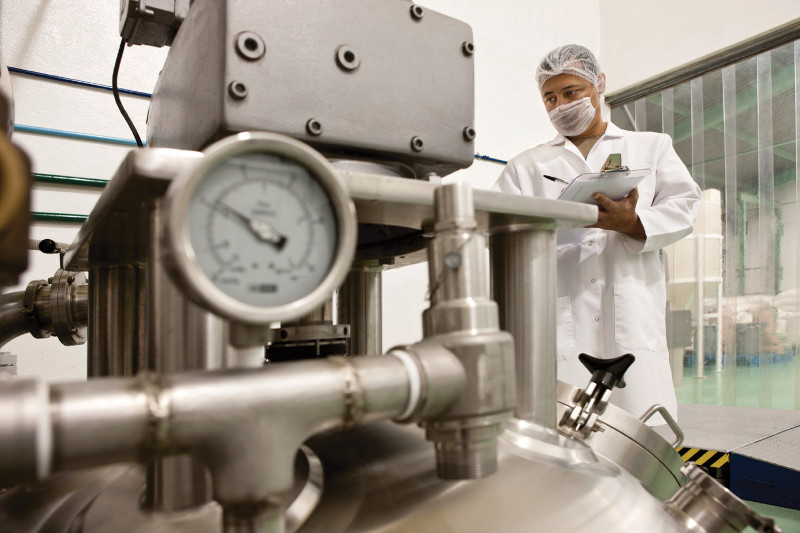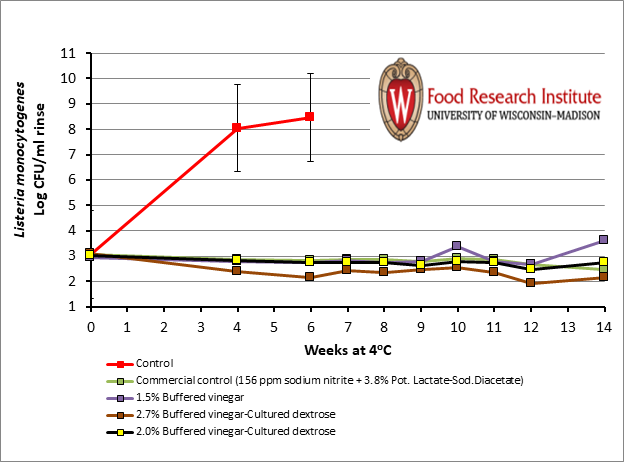Ready to eat (RTE) meat products have short shelf lives unless special precautions are taken to maintain and extend their shelf life. They are subject to spoilage by various bacteria that cause organoleptic and eating quality changes that make them unacceptable to consumers. They are also subject to some pathogenic bacteria that can cause food borne illnesses. The most prominent is Listeria monocytogenes. This particular organism is found commonly in the environment, but it is eliminated in food processing plants by proper cleaning and sanitation. Various interventions have been researched over the past 25 years that can reduce the risk of the presence of Listeria in RTE meat products.

The most common methods include the use of various anti-Listeria ingredients, higher levels of sanitation, and high-pressure processing (HPP). During HPP, the food product, encased in its package, is subjected to ultra-high pressure for a specific period of time. The high pressure is sufficient to inactivate various bacteria, including Listeria, without compromising the nutritional value and quality of the food product. The HPP process has been used for many years by several large meat processors in the USA and is a proven non-thermal technology that does not change the ingredient profile of the food product. Typically, packages of the product are placed into the HPP vessel filled with water where the pressure is increased to about 87,000 psi for around three minutes, then the pressure is released. The whole process including the time to come to pressure, hold, and decompress takes approximately 10 minutes per batch.
High Pressure Processing (HPP) is good, but has practical limitations
There are many aspects of HPP that offer unique benefits through its use. However, its impact of sustainability over ingredient processing could be significant.
What are other options to HPP?
Fortunately, Listeria is sensitive to weak organic acids; consequently, ingredient interventions containing such compounds/chemicals have been found to inhibit the growth of Listeria throughout the whole shelf life of the product, even after package opening. These weak organic acids include vinegar (acetic acid), potassium and sodium lactate, sodium diacetate, and other versions thereof. Many of these ingredients are produced from various fermentations and result with the inclusion of some anti-Listeria peptides as well. An ingredient solution may also provide a more sustainable solution in the production of RTE meat products compared to HPP for several reasons:
-
- More sustainable packaging is possible when it does not need to withstand ultra-high pressures.
- Providing some protection post-opening (secondary shelf life) has the potential to reduce food waste.
- More streamlined processing lines and reduced potential for bottlenecks and extra transportation.
- Improved supply chain flexibility for decarbonization.

A unique blend of organic acids and peptides can improve product quality through clean label inhibition of pathogens and spoilage in RTE poultry products. This product can be used in uncured (no added sodium nitrite) and can work in high moisture-containing poultry products. It results in a more natural color and flavor and is efficacious against Listeria, Clostridium perfringens, and Clostridium botulinum as well as some spoilage organisms. The product is labeled as “buffered vinegar and cultured dextrose” which falls into the more “clean label” category. It has a less expensive cost-in-use than HPP. Studies at the Food Research Institute (University of Wisconsin) have shown no growth in Listeria for 14 weeks (1) when used in a low sodium turkey product (76% moisture, pH 6.2, 1.55% salt) when used at a rate of 2.0% (Fig. 1).
In addition to Listeria, this combination was successfully able to control resistant lactic acid bacteria in fresh poultry (2) and beef systems (3).
Figure 1: Listeria monocytogenes control with Buffered Vinegar and Cultured Dextrose

HPP’s Impact on Food Waste
In a case study where HPP-processed meat waste volumes were measured in foodservice and retail deli counter environments. The main sources were from damaged packaging and products that were not consumed/sold in the short shelf-life after opening. The value captured was significant enough to warrant exploring the waste reduction from the secondary shelf-life extension that would occur through the potential replacement of the process with an ingredient-based solution. Add this to the difference in environmental resources required for the ingredient-based approach versus the energy-intensive process and the impact of the switch became compelling (4). The Kerry Food Waste Estimator was used to give an indication of the volumes of waste that would be reduced downstream through the extra days after opening delivered by the switch.
Conclusions
The old saying that one size does not fit all applies to the different anti-Listeria interventions available to meat processors in the production of RTE meat products. Listeria monocytogenes represents a real threat to the safety of consumers. This is because of increased monitoring, sanitation, and the use of effective antimicrobial interventions. Meat processors have the options of various proven interventions including HPP and various ingredients. The choice of which to use depends upon the company’s business goals and food safety philosophy. So, one shoe does not fit all sizes.
Contributors:
-
References
- Perumalla, S., Sheehan, V., Cooper, R., Ludtke, P., McGough, M., Golden, M.C., Wanless, B.J., and Glass, K. (2016). Efficacy of Clean Label Antimicrobials Against Listeria monocytogenes in Deli-Style Turkey Formulated with Reduced Levels of Curing Agent. Study conducted in collaboration with Kerry and Food Research Institute, University of Wisconsin, Wisconsin, United States. Available online: https://doi:10.221751/rmc2016.121 (accessed on 4 April 2024).
- Furbeck, R., Rumbaugh, K., Hall, N., Saha, J., Kumar, S. Efficacy of Vinegar and Fermentate Preservation System Against Resistant Lactic Acid Bacteria in Marinated Poultry. IAFP 2024. Available online: https://iafp.confex.com/iafp/2024/onlineprogram.cgi/Paper/35304 (accessed on 4 April 2024).
- Furbeck, R., Rumbaugh, K., Saha, J., Kumar, S. Efficacy of Vinegar and Cultured Dextrose Fermentate on Marinated Beef Shelf Life. IAFP 2024. Available online: https://iafp.confex.com/iafp/2024/onlineprogram.cgi/Paper/35313 (accessed on 4 April 2024).
- Reyes, V., Cahill, E., Mis Solval, K.E. (2024). The Potential for Reducing Food Waste through Shelf-Life Extension: Actionable Insights from Data Digitization. Sustainability, 16, 2986. Available online: https://doi.org/10.3390/su16072986

 Saurabh Kumar is a Senior Global Director of Business Development and Innovation for Kerry Food Protection & Preservation. Saurabh has a MS in Food Microbiology from University of Nebraska Lincoln in the United States. Prior to joining Kerry, Saurabh has had over 15 years of experience in food and beverage preservation with global roles of increasing responsibility in the R&D function and business.
Saurabh Kumar is a Senior Global Director of Business Development and Innovation for Kerry Food Protection & Preservation. Saurabh has a MS in Food Microbiology from University of Nebraska Lincoln in the United States. Prior to joining Kerry, Saurabh has had over 15 years of experience in food and beverage preservation with global roles of increasing responsibility in the R&D function and business.  Joyjit Saha is a R&D Manager for Kerry Food Protection & Preservation. Joyjit has a Ph.D. in Food Microbiology from Oklahoma State University and post-doctoral training from University of Florida in the United States. Prior to joining Kerry, Joyjit has had over 5 years of experience in food safety and preservation with roles in the R&D function.
Joyjit Saha is a R&D Manager for Kerry Food Protection & Preservation. Joyjit has a Ph.D. in Food Microbiology from Oklahoma State University and post-doctoral training from University of Florida in the United States. Prior to joining Kerry, Joyjit has had over 5 years of experience in food safety and preservation with roles in the R&D function. 

